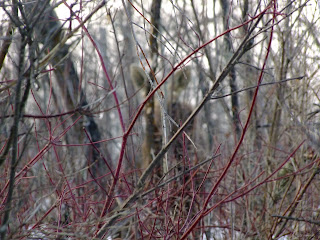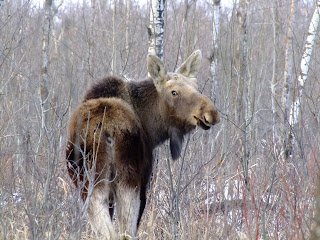Wild Sarsaparilla, Edmonton River Valley, June 2013. Photo by Jason.
When I first saw these little white-flowered spheres popping up in the river-valley undergrowth a few weeks ago, I was confused, thinking at first they were a wild onion. I soon figured it out that no -- not onion-y at all, and that my difficulty in identifying stemmed from the fact that I only knew this plant by its late summer cluster of berries, rather than its early blooms.
This is the wild sarsaparilla (Aralia nudicalis). Also known as rabbit root, wild licorice (not to be confused with this true wild licorice), shotbush and small spikenard.
Parts to use: the roots only (berries are inedible)
Uses: blood purification, energy tonic, skin washes for ulcers, rashes and pox.
Sarsaparilla is a delightful word. It is from the Basque words sartzia 'bramble' and parra 'vine', and reached English via the Spanish zarzaparilla -- the invading Spaniards encountered indigenous people in Central America using the plant both medicinally and in enjoyable beverages that were the precursor to our contemporary root beers. These plants, of the Smilax genus, are the true sarsaparillas, whereas the wild sarsaparilla is part of the ginseng family and was so named in English because the taste and qualities are very similar to that of the original sarsaparilla of the southern regions.
Wild sarsaparilla, which is found growing throughout moist and moderately shady woods in North America, is also now widely used to flavour many commercial traditional-style root beers. The plant grows about a foot high, and may have two to five-ish little branching umbels of greenish white flowers appearing in May or June. The purplish black berries that appear in July and August are not edible for humans, but bears seem to enjoy them. The part most useful for medicine are the dried rootstalks, which should be gathered in early autumn, as the plants begin to yellow.
Once the roots are dried, they can be made into a tea, which has general tonic properties much like ginseng does, restoring energy and purifying the blood. It has a lovely peppery-balsamic taste, with a hint of licorice, like the dominant root beer flavour. Like ginseng, it can cause a bit of extra perspiration (which adds to its purifying qualities).
While again, I am not a herbalist or botanist, I would advise that it should be used with caution if you are sensitive to other Panax or Aralia plants; however, while I have adverse effects from ginseng (blood pressure drops and heart palpitations) I can have small amounts of wild sarsaparilla in teas and root beers, so it makes a nice substitute for the stronger plants with similar benefits.
My dad also learned from a Woods Cree friend that the plant was also used to make a skin wash that was helpful in soothing ulcers, psoriasis-like skin issues and shingles/chicken pox rash. In the past the plant had also been used to treat syphilis, though which symptoms he didn't know.
This plant always makes me remember my dad, because when I was little and being mildly mischievous, he would always scold me with 'you little sarsaparilla!', dropping the 'r' so it sounded like 'sass'. And this is a sassy and delicious plant indeed.





